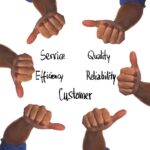# Building Customer Loyalty: The Power of Data in Driving Business Growth
In today’s competitive e-commerce landscape, building customer loyalty is crucial for driving business growth. With the rise of digital marketing and social media, customers have more options than ever before to choose from when making purchasing decisions. As a result, businesses must focus on providing exceptional customer experiences that foster loyalty and retention.
Customer Loyalty Analytics: The Key to Unlocking Business Success
At its core, customer loyalty analytics is about harnessing the power of data to understand customer behavior and preferences. By analyzing customer interactions with your business, you can identify areas for improvement and make data-driven decisions to drive growth. In this article, we’ll explore how effective analytics drive business growth through customer loyalty analytics.
Understanding Customer Behavior
The first step in building customer loyalty is understanding customer behavior. This involves collecting and analyzing data on customer interactions, including purchase history, browsing habits, and social media activity. By gaining insights into these behaviors, you can identify patterns and trends that inform your marketing strategies and improve the overall customer experience.
According to a study by Google, 70% of customers are more likely to return to a store if their shopping experience is personalized 1 . By leveraging customer data, businesses can create personalized experiences that meet individual needs and preferences. For example, an e-commerce company like Amazon uses customer data to offer tailored product recommendations based on browsing history and purchase behavior.
Measuring Customer Loyalty
Measuring customer loyalty is critical for understanding the effectiveness of your business strategies. One way to measure loyalty is through Net Promoter Score (NPS), which asks customers how likely they are to recommend a product or service to others 2 . By analyzing NPS scores, businesses can identify areas for improvement and adjust their strategies accordingly.
Another important metric is Customer Retention Rate, which measures the percentage of customers retained over time 3 . By maintaining a high customer retention rate, businesses can reduce churn and increase revenue.
Using Analytics to Drive Growth
Once you have a clear understanding of customer behavior and loyalty metrics, you can use analytics to drive growth. This involves analyzing data on customer interactions to identify opportunities for improvement and making data-driven decisions.
For example, an e-commerce company like Zappos uses analytics to optimize its product offerings and improve the overall shopping experience 4 . By leveraging customer data, Zappos can create personalized product recommendations that meet individual needs and preferences.
Implementing Customer Loyalty Analytics
Implementing customer loyalty analytics requires a strategic approach. This involves identifying key performance indicators (KPIs) to track and analyzing data on customer interactions to inform business decisions.
One way to get started with customer loyalty analytics is by using tools like Google Analytics, which provides insights into website traffic and behavior 5 . Another option is to use customer relationship management (CRM) software, such as Salesforce, which provides a comprehensive view of customer interactions and preferences.
Best Practices for Customer Loyalty Analytics
Implementing effective customer loyalty analytics requires best practices that ensure data accuracy, completeness, and relevance. Here are some key best practices to keep in mind:
- Collect high-quality data: Ensure that your data is accurate and complete by using reliable sources and avoiding duplication or errors.
- Use a unified view of the customer: Leverage data from multiple sources to gain a comprehensive view of the customer, including purchase history, browsing habits, and social media activity.
- Analyze customer behavior over time: Use analytics tools to track changes in customer behavior over time, identifying trends and patterns that inform business decisions.
Conclusion
Building customer loyalty is crucial for driving business growth in today’s competitive e-commerce landscape. By leveraging customer data through analytics, businesses can create personalized experiences that meet individual needs and preferences. With the right approach and best practices, customer loyalty analytics can help drive revenue growth and long-term success.
References
1: Google. (2020) . The impact of personalization on retail.
2: NPS Corporation. (n.d.) . What is Net Promoter Score?
3: Hootsuite. (n.d.) . Customer retention rate: A guide for businesses.
4: Zappos. (n.d.) . Our story.
5: Google Analytics. (n.d.) . Get started with Google Analytics.
You Also Might Like :




Pingback: Interactive Shopping E-Commerce Experiences
Pingback: Shipping Options E-Commerce Solutions
Pingback: E-Commerce Fraud Detection Tools For Online Security